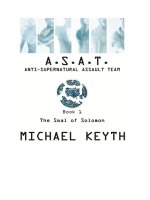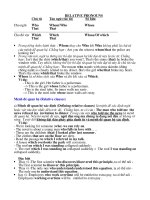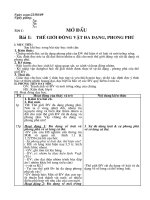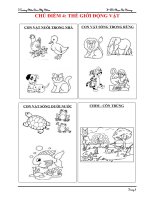relative clausepart 1 relative clausepart 1 i relative pronouns who whom which where when whose why what that iirelative clauses 1 the relative pronounis the subject of the relative cl
Bạn đang xem bản rút gọn của tài liệu. Xem và tải ngay bản đầy đủ của tài liệu tại đây (76.25 KB, 3 trang )
<span class='text_page_counter'>(1)</span><div class='page_container' data-page=1>
RELATIVE CLAUSE(part 1)
<b>I/ Relative pronouns:</b>
<b>Who ,whom, which, where, when, whose ,why , what, that . </b>
<b>II/Relative clauses:</b>
<b>1/ The Relative pronounis the subject of the relative clause :</b>
Ex : I don't like the man . He lives next door .
---> I don't like the man who lives next door.
I don't like the book . It tells about a famous actor.
---> I don't like the book which tells about a famous actor.
<b>NOTE:"That" can replace " who" and " which"</b>
The relative pronoun can't be omitted.
<b>2/ The relative pronoun is the object of the relative clause :</b>
Ex: Have you read the book ?. I lent you that book last week.
---> Have you read the book which I lent you last week ?
I like the shirt . You are wearing it.
--> I like the shirt which you are wearing.
<b>NOTE:</b>
"That" can replace " Who"," whom" and " which".
The relative pronoun can be omitted.
<b>3/ The relative clause with preposition: </b>
Ex:I don't like the hotel . We are living in that hotel
---> I don't like the hotel which we are living in.
(OR) --> I don't like the hotel in which we are living.
That girl is my sister.You are talking about her
--> The girl who/(whom)you are talking about is my sister.
(OR) --> The girl about whom you are talking is my sister.
<b>NOTE:</b>
" That"can replace "who" ," whom" and " which" when the preposition is at the end of the
relative clause.
In formal English preposition are pled before the relative pronoun.
<b>III/There are 3 kinds of relative clause : Defining, non- defining and </b>
<b>connective.A/Defining relative clauses :</b>
<b>1/ A defining relative clause specifies which person or thing we mean . It can not be </b>
<b>separated from the person or thing it describes</b>
Ex:
The man who told me this refused to give me his name
( "Who told me this " is a defining relative clause . If we omit this . it is not clear what the
man talking about )
<b>Notice that there is no comma between a noun and a defining relative clause.</b>
-Defining relative clause usually follow "the"+ Noun but they can be also be used with "
a/an" + noun, plural nouns without "the" and the pronouns : all, none , anybody ,
somebody... and those .
-Clauses following " a/an"+ noun , plural nouns without
</div>
<span class='text_page_counter'>(2)</span><div class='page_container' data-page=2>
noun/ pronoun in these cases is usually the object of a verb or preposition.
Ex:
A doctor is a person/ someone who gives patients medical treatment.
I met a person who said he knew you.
-Sometimes these clauses are separated from their noun/ pronoun by a word or phrase
Ex:
I saw something in the paper which would interest you
-But normally, relative clauses should be placed directly after their noun /pronoun
Ex :
Is there anything i can do to help ?
The noise that he made woke everybody up.
<b>2/ Relative pronouns used in defining relative clauses :</b>
+/ For persons -- Subject :who /that
-- Object : who/whom/that
--possesive : whose
<b>a/ Subject : who/ that</b>
"Who" is normally used but "that" is a possible alternative after " all/ everyone/
everybody/noone/ nobody/ those
Ex:
The man who has just come is our headmaster .
Only those who had booked in advance were allowed in.
<b>b/ Object of a verb :Who/whom/that"Whom" is the Object form of " who" and is used </b>
formally in object clauses
Ex:
He is a person whom you can rely on
-However, this is noun felt to be excessively formal by most speakers and " who" is
commonly used instead ( that is more usual than "who").And it is still more common to
omit the object pronoun altogether.
Ex:
The man whom i saw told me to come back today.
(OR) The man who i saw..../The man i saw.../ The man that i saw ....
<b>c/ With a preposition : Whom/ that</b>
- In formal English " whom" has to be used if it follows a preposition.
Ex :
To whom Am I speaking?
-In formal speech , however, it is more usual to move the preposition to the end of the
clause. "Whom" then is often replaced by " that", but it's still common to omit the relative
altogether.
Ex:
The man to whon i spoke.
(OR) The man who/ whom i spoke to
(OR) The man that i spoke to/ The man i spoke to
-However , in everyday use, it's usual to avoid this kind of construction
Ex:
</div>
<span class='text_page_counter'>(3)</span><div class='page_container' data-page=3>
<b>d/Possessive :</b>
- Whose = " of whom" and "whose" is the only possible form
Ex:
Several guests whose rooms had been broken into complained to the manager.
</div>
<!--links-->









